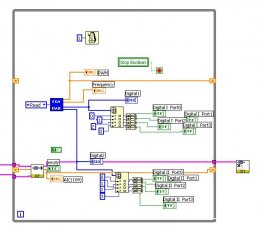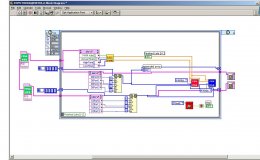ashm01
2006-01-31 11:10:44 UTC
Hi,
I have a very STRANGE issue here, I migrated my working Labview 7.1.1 RT code to Labview 8.0 and noticed the performance degradation beyond acceptance level.:smileymad:
I use "RT Simple CPU Usage.VI" to check the CPU resources. I usually poll the FPGA cards in a time critical VI, (I have 2 FPGA cards). After polling I use a FGV to transfer it out into a normal priority thread and process it. In Labview 7.1 my CPU Usage never exceed 40%. However in labview 8 it?s a constant 100% . I have attached a screen shot of my 7.1 Vi's which have been migrated to 8.0.
The processing would be comparing values, storing to disk etc. However, the FGV?s in Labview 8 are hogging up the resources and that seems to be the bottle neck. ( I disabled every other loops/ tasks inorder to come down to this conclusion). I also tried using the so called "Shared variables w/FIFO's enabled" and the result is still the same. if i disable the reading of the FGV's, my idle usage with polling is 20%. This doesn't make sense to me, in theory what works in LV 7.1 should work in 8.0.
Also, I cannot switch to LV7.1 once 8.0 is installed. Does anyone know the dependencies required to bring it back to 7.1 through the MAX "add/remove software"?
Please advice.
NP-Reader.JPG:
Loading Image...
TC-POLLFPGA's.JPG:
Loading Image...
I have a very STRANGE issue here, I migrated my working Labview 7.1.1 RT code to Labview 8.0 and noticed the performance degradation beyond acceptance level.:smileymad:
I use "RT Simple CPU Usage.VI" to check the CPU resources. I usually poll the FPGA cards in a time critical VI, (I have 2 FPGA cards). After polling I use a FGV to transfer it out into a normal priority thread and process it. In Labview 7.1 my CPU Usage never exceed 40%. However in labview 8 it?s a constant 100% . I have attached a screen shot of my 7.1 Vi's which have been migrated to 8.0.
The processing would be comparing values, storing to disk etc. However, the FGV?s in Labview 8 are hogging up the resources and that seems to be the bottle neck. ( I disabled every other loops/ tasks inorder to come down to this conclusion). I also tried using the so called "Shared variables w/FIFO's enabled" and the result is still the same. if i disable the reading of the FGV's, my idle usage with polling is 20%. This doesn't make sense to me, in theory what works in LV 7.1 should work in 8.0.
Also, I cannot switch to LV7.1 once 8.0 is installed. Does anyone know the dependencies required to bring it back to 7.1 through the MAX "add/remove software"?
Please advice.
NP-Reader.JPG:
Loading Image...
TC-POLLFPGA's.JPG:
Loading Image...